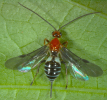Scientific name
Myosoma chinensis (Szepligeti) (=Bracon chinensis, Microbracon chinensis, Amyosoma chinensis)
Taxonomic position
Hymenoptera: Braconidae: Braconinae
Diagnosis
Head reddish-testaceous in female, ocellar triangle black with a pair of dark brown to black patches on either side; uniform dark pitchy brown to black in male. Antenna dark brown to black, very long, only slightly shorter than body length. Mesosoma in female reddish-testaceous, smooth and shiny; propodeum medially darker, brown to black; slightly darker in male with pronotum and apex of scutellum brownish. Metasoma (abdomen) smooth and shiny, petiole (tergum 1) with median tergite black, laterotergites white; terga 2-6 black, posterior margin with a narrow white band.
Ovipositor prominent, but shorter than body, a little more than 3/4th as long as metasoma. Median
tergite of petiole (tergum 1) very long and narrow, more than 2.5x longer than maximum width. Second
metasomal tergum more or less triangular. Hind tibia and femur markedly flattened, densely setose with long marginal setae; hind tibia slightly enlarged / swollen towards posterior with a lateral longitudinal groove.
 Abdomen, male Abdomen, maleImages



 Adult female, dorsal view Adult female, dorsal view

 Male, dorsal view Male, dorsal view
Distribution
Widely distributed in the Oriental region. India. Sri Lanka. Taiwan. Malaysia. Indonesia. Introduced in Mauritius (from Sri Lanka), Hawaii, and the US (from India).
Hosts / Biology
Commonly collected in association with graminaceous stem borers on rice, sorghum, maize, and sugarcane, particularly, Chilo partellus (Swinhoe), and other Chilo spp.,
Scirpophaga excerptalis and Sesamia inferens.
Reference
- Quicke, D.L.J. 1987. The Old World genera of braconine wasps (Hymenoptera: Braconidae). Journal of Natural History, 21: 43-157.
|